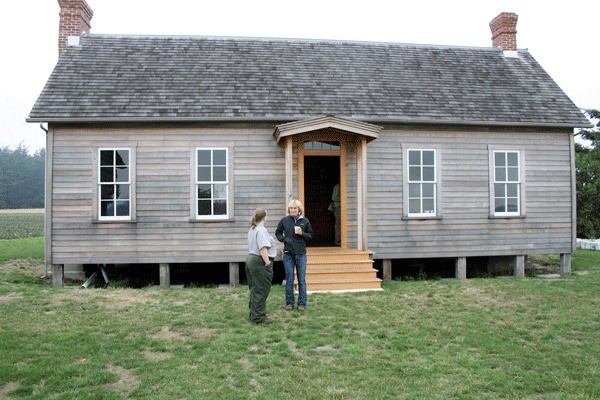The home of one of Whidbey Island’s pioneer families is coming back to life.
After a four-year renovation project, the long-vacant Jacob Ebey House, which is located near Sunnyside Cemetery and overlooks Ebey’s Landing, will open next spring as a visitor center for hikers in the Historical Reserve.
The two-story house was built in the mid-1850s and cost approximately $400,000 to rehabilitate.
Reserve Manager Mark Preiss said workers tried to use as much of the home’s original material as possible throughout the building. The siding on the ends of the home and the windows are all original to the building. Workers also had to raise the house, including chimneys, three feet so they could install a new foundation. A new door, walkway and ramp were added.
“They did an awesome job on this place and it looks great,” Island County Museum Director Rick Castellano said Wednesday morning. He was one of the 20 or so people attending a preview of the new building that also included the unveiling of the reserve’s long-range interpretive plan.
Preiss said the home will be ready for the public in the spring of 2011. Workers still need to install power and water to the home.
The home will also house historical exhibits. Preiss said reserve staff will work with museum officials to come up with exhibits about Whidbey’s earliest families, the island’s agricultural history and mid-19th century pioneer life.
“The Jacob Ebey House is going to be a community resource,” Preiss said.
The house is one of the key components to the interpretive plan, which residents had the chance to review for the first time Wednesday.
Preiss said the process of developing the new plan has taken as long as the Ebey House rehabilitation itself. He credited the community input and stewardship as a key factor in forming the 41-page document.
Emi Morgan, reserve education coordinator, gave a brief presentation about the reserve’s environment, historical landscape and cultural heritage.
She said one of the goals of the new document is to educate visitors about areas that may not be so well known.
“We want to make sure all of our educational components aren’t focused on Ebey’s Landing,” Morgan said, adding other notable areas, such as north Penn Cove and Crockett Lake, would also attract visitors to Whidbey Island.
There is also language about attracting more agri-tourism to Whidbey Island by developing more events. She added better signs identifying Whidbey’s farms, a crop calender and advertising of farm events are also included in the program.
If the interpretive plan increases the visibility of the reserve, at least one resident has a concern about increasing the number of visitors to Ebey’s Landing.
Karen Bishop, owner of Ebey Road Farm, wondered where all of the additional people will park when they visit the reserve. She noted that, during a recent wedding at Ebey’s Landing, cars were parked along Ebey’s Road, effectively blocking one lane of the road.
She was also concerned about the effect large numbers of cars parked alongside Central Whidbey roads would have on the visual scenery that makes the area popular.
“I just hope the have a good plan for that,” Bishop said.



